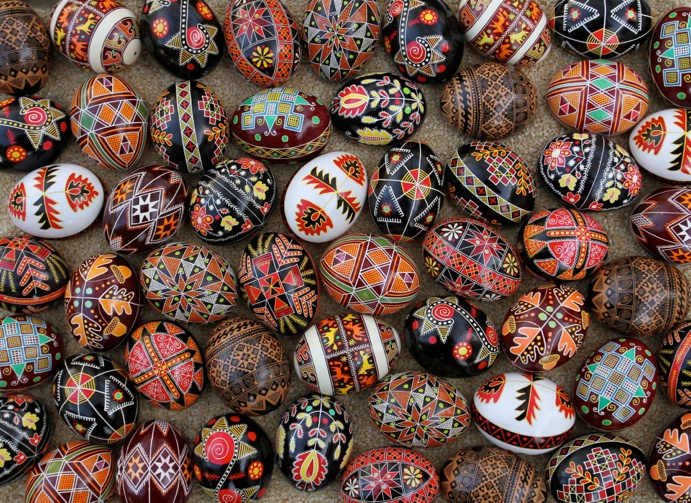2013

While Easter came quite late in 2013 (May 5th), that doesn’t mean I had a lot of time for writing pysanky. Two things got in my way. First of all, I spent March in India, as it was an odd numbered year. And second, I spent all of February getting ready for our big exhibition of pysanky in Detroit.
What exhibition was that, you may ask? The Detroit Historical Museum invited the Ukrainian community of Detroit, through the Ukrainian American Archives and Museum of Detroit, to organize an exhibit about the Ukrainian immigrant experience in Detroit. The organizers of the exhibit decided they wanted lots of pysanky in the exhibit so they turned to me and a few other pysankary. I lent them my entire collection of traditional and diasporan pysanky, some 1700 eggs, and more than half of those ended up being exhibited. In all there were 1300 pysanky on display in all sorts of display cases in 2 rooms of the DHM. It was beautiful, but a hell of a lot of work.
I had to sort, label, and photograph all of my pysanky before handing them off. That took me most of February. In addition, I wrote all of the text about pysanky for the exhibit, including a long essay about symbolism, which was later included in the UAAMD newsletter. (Download here.) I was away when the exhibit was set up, but came back in April and visited many times, photographing the exhibit, and taking friends around. I wrote a companion guide to the exhibit, which was xeroxed and made available for visitors, describing the pysanky in each of the cases, along with their ethnographic origins and characteristics. You can see photos of the exhibit on Facebook here (see the 4th through 6th pages of albums).
All that simply means that I didn’t have as much time as usual, and this is reflected in the number and variety of pysanky I chose to write. I wrote a mix of diasporan and traditional designs, many taken from Elyjiw. I find his book to be an incredible source of knowledge and designs. Each time I look thorough its plates, I find pysanky I hadn’t noticed before, and get new insights about symbols and regional variations. The photos are often of older pysanky, with faded colors; once written anew, they simply glow and the designs pop and amaze.
Although I wrote specific designs with my various nieces and nephews in mind, I let them choose from all of my pysanky. I wrote the first pysanka below with the girls in mind; it is a goddess/berehynia pysanka, even though the example below is missing its arms (you can see the arms in the photo above). You can clearly see the crown, though. The second pysanka, with horses, was written with the boys in mind, but proved popular with everyone. I wrote a dozen each of both designs, although began to question the wisdom of this when I recalled I didn’t know how to draw horses, and each of the horse pysanky below has 16 of them (or 192 altogether).
As in previous years, I wrote many traditional pysanky, including 2 from Kozats’ka Sloboda, and many Hutsul designs, including a few from Kosmach, albeit not the prototypical Kosmach style. I also wrote a lovely white pysanka, done the proper way with etching. And there were several diasporan designs, and one of my own brown egg designs.
All in all, it was a nice bunch of pysanky. My favorite? Elyjiw 71-7.






